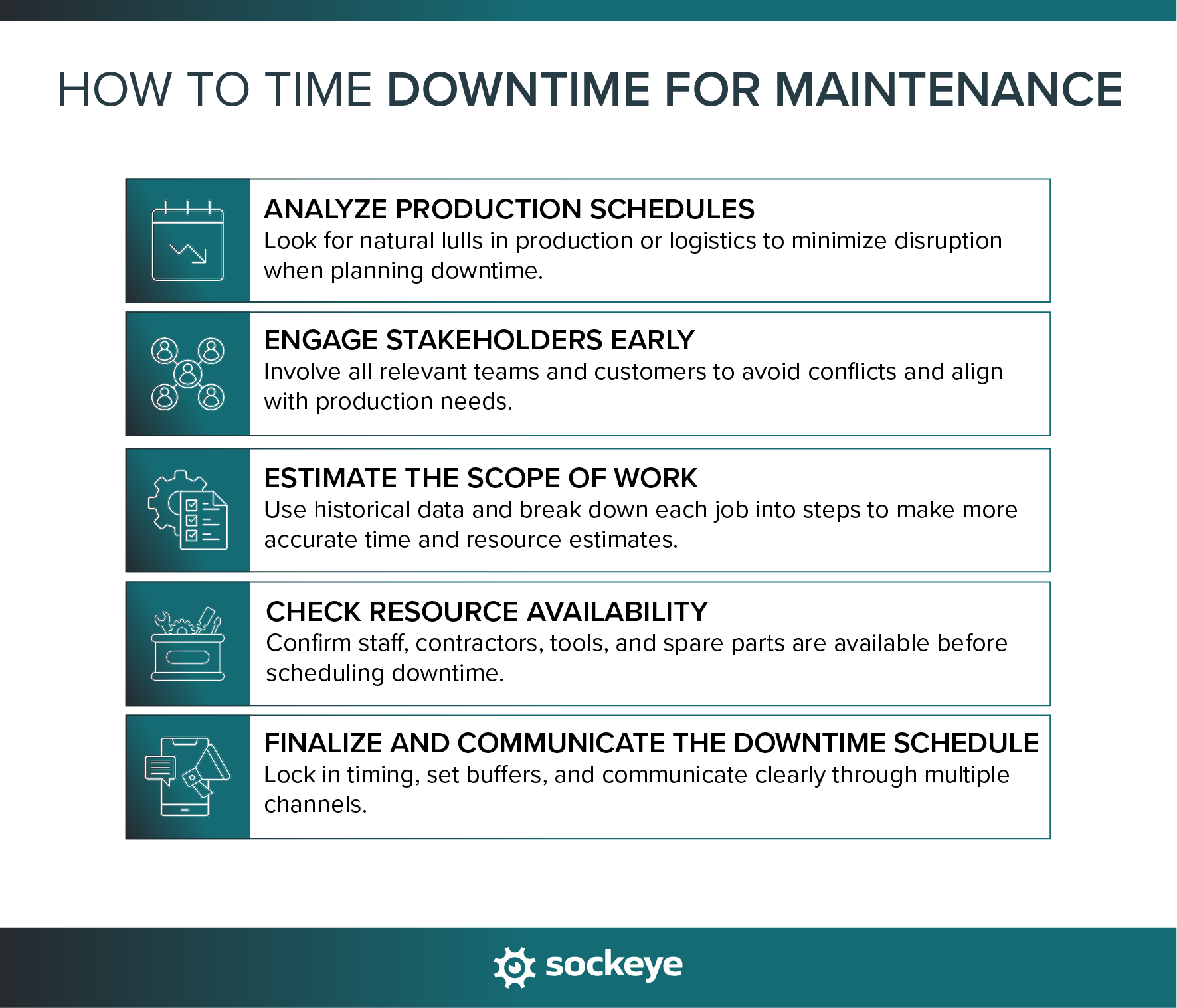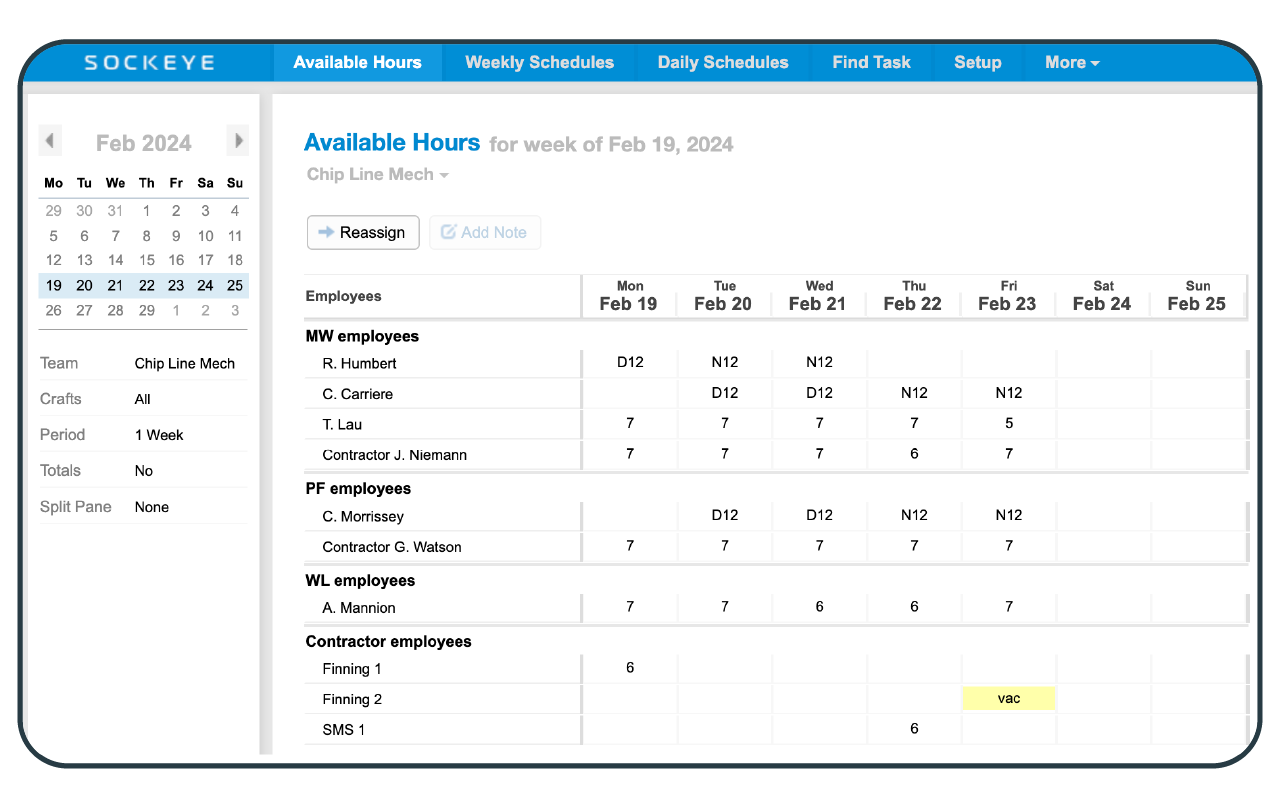In manufacturing, downtime often gets a bad rap. Machines aren’t running, production stops, and revenue feels like it’s on pause. But when planned well and ahead, maintenance downtime is not a wasted time — it’s an investment that will make you more productive in the long run.
Maintenance downtime simply means taking equipment offline for repairs, inspections, or upgrades. Unlike IT downtime (which can sometimes happen in the background without anyone noticing), when production lines stop, the impact is immediate.
That’s why preparation is key: the smarter you use your downtime schedule, the less it hurts and the more value it delivers.
Choosing the right time for maintenance downtime
Deciding when to take machines offline will have a big impact on the rest of your maintenance (and production) schedules. Here’s what to keep in mind to find the right time.

1. Analyze production schedules
Look for natural dips in activity. Many plants already have slow periods during shift changes, product changeovers, or seasonal lulls — these are prime candidates for planned maintenance. Also, check upstream and downstream impacts: a supplier’s delay or a customer’s holiday shutdown might give you the perfect window.
Example: If your busiest months are October–December, consider scheduling major maintenance in January when orders slow or in September to make sure the assets are in good condition for the busy season. Similarly, if Mondays are heavy shipping days, schedule downtime mid-week when logistics aren’t under pressure.
2. Engage stakeholders early
Don’t plan in isolation. Involve production managers, line operators, logistics, and even key customers (if delivery schedules could be affected). This helps you catch blind spots — like a critical rush order you didn’t know was coming — or align with other planned stoppages.
Example: A plant scheduled a weekend shutdown for upgrades only to discover sales had promised a Monday delivery. By looping in the sales team weeks ahead, they could shift the maintenance to align with production needs instead of scrambling at the last minute.
3. Estimate the scope of work
Not all maintenance jobs are equal — swapping out a worn belt might take just a couple of hours, while major line reconfiguration could need an entire weekend. Use your CMMS, OEE data, and past maintenance logs to get a more realistic picture of how long work takes.
A few tips:
- Break down each job into steps and add time estimates.
- Review what caused delays in the past — cleanup, unexpected parts issues, or extra inspections.
- Bundle multiple tasks into one downtime window. Since the asset is going to be offline, you might as well do some preventive work that is coming up soon.
In general, it’s a good idea to overestimate slightly to have a small buffer; unplanned overruns are much worse than finishing early.
4. Check resource availability
There’s no point scheduling downtime if your team or contractors aren’t available. Make sure:
- Key staff aren’t on vacation or tied up elsewhere.
- Any specialist contractors or inspectors are booked well in advance.
- The necessary spare parts, tools, lubricants, and consumables are on hand.
Maintenance downtime scheduling is way easier when you have a scheduling bolt-on like Sockeye. Sockeye integrates with any CMMS or EAM software, and its main goal is to speed up and simplify maintenance scheduling. A big part of that is its real-time crew and contractor availability dashboard. The availability data is based on your shift patterns and can be updated with just a couple of clicks.

No more juggling spreadsheets or navigating through 7 different screens — quickly see who’s available when and schedule accordingly.
Here is how that availability data is used in action, when scheduling PMs or repairs.
5. Finalize and communicate the downtime schedule
Once you’ve aligned on timing, scope, and resources, lock in the schedule.
- Set clear start and end times with some contingency buffer. Don’t forget to include cleanup and restart times — these are often underestimated.
- Communicate early and often: let all stakeholders know at least a week ahead, ideally more (depending on the job size and how long the assets will need to be off).
- Use multiple channels — meetings, emails, digital dashboards — so nobody’s caught off guard.
Example: A plant might post downtime notices on a digital board near the break room a week ahead and send reminders 24 hours before. If it has access to Sockeye, everyone on the team should see the downtime date(s) on the live schedule at least a week in advance.
Sidenote: Sockeye allows you to schedule work up to 5 years in advance. You probably won’t go that far ahead, but we have seen major production line overhauls be scheduled 6 to 12 months ahead.
Preparing for the scheduled downtime
Once the downtime is on the calendar, the real prep begins. A smooth maintenance window depends on how well you set things up beforehand.
- Pre-stage materials and tools: If possible, gather everything you’ll need in advance: spare parts, lubricants, safety gear, testing instruments. Store them close to the work area so your team isn’t wasting time chasing missing items.
- Assign clear roles: Decide who’s leading the job, who’s supervising, and who signs off at the end.
- Plan safety measures: Downtime work often means opening up machines and electrical panels. Make sure lockout/tagout checklists and PPE requirements are in place. Safety delays are costly, but easily preventable.
- Get documentation ready: Have work instructions, equipment manuals, and permits on hand (in either physical or digital form). You do not want administrative work to chew through your downtime window.
- Leverage digital tools: Use your maintenance software to issue work orders, track progress (especially if it spans multiple days), and attach digital checklists or manuals to tablets/phones.
Execution: Making the most out of downtime maintenance
The window is here, the clock is ticking. The goal is to stick to the plan.
One of the easiest ways to lose time is at the very start — setup delays are a common culprit. Make sure your crew, tools, and materials are ready to go before the scheduled start time so work begins on the dot.
During the downtime, stick to the workflows and checklists you prepared. Improvisation is good when something unexpected happens, but otherwise, it leads to missed steps or rework. Your prep work was done for a reason — use it.
As the work unfolds, keep a close eye on progress. Log any delays, missing parts, or unexpected findings as they happen. This real-time tracking not only helps you manage the current job but also provides valuable insights for the next downtime window.
Finally, maintain open communication with production and other stakeholders throughout the process. If the timeline changes — good or bad — let them know immediately so they can adjust plans downstream.
After the work is done: Review & continuous improvement
When the machines are back online, don’t just move on and forget about the downtime. A quick review can save you headaches next time. Gather the team for a short debrief while the details are still fresh. Talk about what went well, what caused delays, and what unexpected issues popped up.
Update your maintenance records with any changes, findings, or parts replaced. This keeps your data accurate and helps refine future plans. This will help your planners and schedulers make the next downtime cycle smoother and more predictable.
It can also be helpful to track metrics like Mean Time to Repair (MTTR) and schedule compliance. These numbers can give insight into how effective (and realistic) your downtime planning is.
Make every maintenance window count
Scheduling downtime for maintenance is also an opportunity to improve equipment reliability, boost safety, and even increase long-term productivity.
Managers who treat downtime as an efficiency multiplier tend to see the best results. Careful preparation, good communication, and tracking what works (and what doesn’t) help you get more value out of every hour the line is offline.
Digital tools make this even easier. A CMMS helps you create accurate job plans, while tools like Sockeye simplify scheduling with maintenance automation and real-time labor availability dashboards. To learn more about Sockeye, jump on a quick call with our team or check out our FAQ section.